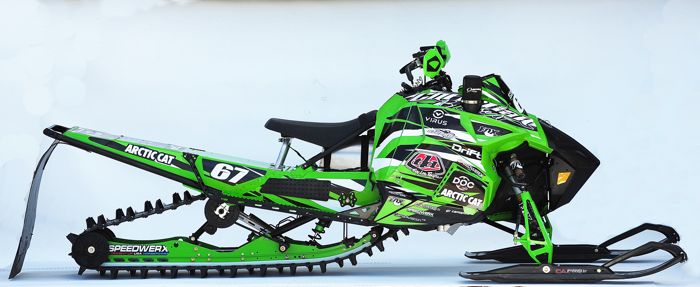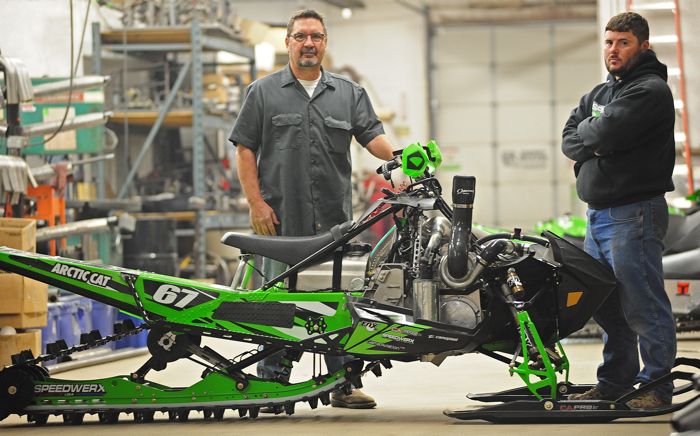
This past winter ESPN added hillcross to its winter X Games event in Aspen, Colo., joining snocross and freestyle for snowmobile-focused events. The exciting uphill snocross/hillclimb hybrid event delivered exciting acceleration and massive jumps.
What it probably lacked, however, was drama. For that we can blame Ryan Simons, Speedwerx and Christian Brothers Racing.
That’s because Simons was in a class by himself, emphatically crushing every heat and final en route to the gold medal – his first in a stellar career that also includes a silver and bronze in snocross.
Simon’s masterful victory had a lot to do with his talent, of course. He’s one of the most accomplished terrain racers of the past decade.
It also had much to do with the very custom Arctic Cat mod sled, built to the hilt by Speedwerx with help from Hector Olson and Cory Berberich from Christian Brothers Racing.
It began life as a 2014 Arctic Cat ZR6000R SX race sled, a nod to the fact that hillcross events are effectively more snocross than hillclimb.
“We wanted to start with a chassis that had proven itself in the big jumps,” says Jeremy Houle of Speedwerx.
Race rules for hillcross required a minimum of a 150-in. track, so Speedwerx reached deep into the Arctic Cat parts catalog to find the company’s Attack 20 track of that same length, a 15 x 150 x 1.7-in. hoop designed as a competition track for the 2007-08 M Series 153-in. sleds.
Suspending the track was the Arctic Cat SLIDE-ACTION snocross skidframe bolted onto reinforced 150-in. rails from IceAge performance, and incorporating FOX-built shocks utilizing Arctic Cat’s Cross-Link system that hydraulically couples the front and rear shocks. (Note: Simon’s used Cross-Link at X Games, but they were pulled off for a different project after the event and were not on the sled at the time of the photo shoot.)
Perhaps the most visible customized feature of the Speedwerx-built sled is the minimalist ATV seat.
“The original plan was that Ryan would use this sled for hillcross and then race at the Jackson Hole hillclimbs,” said Jeremy. “The small seat is ideal for hillclimbs because it’s so unobtrusive. In hindsight, it might not have been the best seat for hillcross though because it didn’t allow Ryan to squeeze and hold it with his legs they way he would a regular seat.”
Nestled underneath the seat is an equally diminutive 3.5-gallon aluminum fuel tank, chosen for its low weight and minimal fuel sloshing effect. The tank is now an available part from Speedwerx.
The other visibly striking element of the sled is the massive intake mouth poking out of the hood signaling the sled’s single most potent performance system: the Speedwerx Procharger Supercharger mated to the 800 H.O. Suzuki engine.
Cranking out 300-hp (but without the inherent lag associated with turbo-charging) with 12-14 lbs. of boost, the Speedwerx Supercharger gave Simons (and three other Speedwerx/Arctic racers) an advantage over every other racer in Aspen, if not in raw power than for sure in their ability to instantly access it. That’s because the other boosted engines at X Games were done so with turbo-charger, which has an inherent lag. Supercharging has no such lag, it’s added power is instant, which is exactly what racers and mountain riders want.
In addition to its monster Supercharger (complete with water-to-air-cooled intercooler for maximum hp), Speedwerx also trued and welded the engine’s crankshaft and used forged pistons for added durability. A Speedwerx exhaust and Y-pipe helped breathe more horsepower into the equation while C-14 114-octane fuel was premixed with Arctic Cat C-TEC2 oil. Stock Arctic Cat clutches were used, albeit with Speedwerx calibration.
The supercharged engine caused enough worry to the competition at Aspen that ESPN officials inquired about the displacement of the Simons’s engine prior to his first run up the mountain.
“From what we gathered that weekend, another race team believed that we had illegally bored the cylinders beyond 800cc,” says Jeremy, “Which we hadn’t, which was confirmed after the engine was tore down following Ryan’s win. The cylinders are bone-stock. We didn’t even port them, which is legal but unnecessary since we already have more than enough horsepower to win. I think they [the competition] were simply hoping for a hail mary.”
Once Simons began his runs, the supercharger’s instant response was immediately apparent.
At the start and every time he landed off a jump, he gained a couple sled lengths,” said Steve Houle. “That’s a lot of sled lengths.
“That’s the beauty of supercharging. It’s like riding a conventional engine, but on steroids. There’s no having to anticipate or “time” the power delivery. It’s always on.”
Said Jeremy Houle: “After the race, Simons remarked that winning the gold in hillcross was 100-times easier than winning silver and bronze in snocross.”
Last year there were four Team Arctic racers competing at X Games with a Speedwerx Supercharger: Simons, Dave McClure, Rob Kincaid and Taylor Meuwissen. McClure and Kincaid also had sleds built that were nearly identical to Simons’s.
A couple months after X Games, Team Arctic’s Wes Selby built a replica of this same sled and went undefeated in hillcross and hillclimbs at the Ultimate Snowmobiler event in Crested Butte, Colo. In fact, three of the nine riders who are pre-qualified for next year’s X Games hillcross include Simons, Selby and Meuwissen.
Likewise, Team Arctic’s Garth Kaufman (together with Kirk Hibbert) built a 600 C-TEC2 version of this sled, complete with a Speedwerx supercharger, and then notched five podium finishes in end-of-the-season RMSHA hillclimb events.
Oh, and Kirk himself came out of retirement to win a hillclimb with the same sled!
After achieving such remarkable success in its maiden year, the sled will be available from Speedwerx for this coming season, built nearly identical to what you see here. The price tag will be around $22,000 to $25,000.
It should be noted that, in addition to the Houles, Hector Olson and Cory Berberich, that Ron Gilland from Speedwerx also played a big role in building these sleds by doing the majority of the fuel mapping.
And as mentioned at the beginning of the story, Ryan Simons himself played a huge role in its success.
“Ryan has enough talent that he would have fought for the win on a more conventional sled,” said Steve Houle. “He showed a lot of those guys how hard they needed to hit the jumps if they wanted a shot at a medal.”
Thanks for reading. Enjoy some more beauty shots below.
